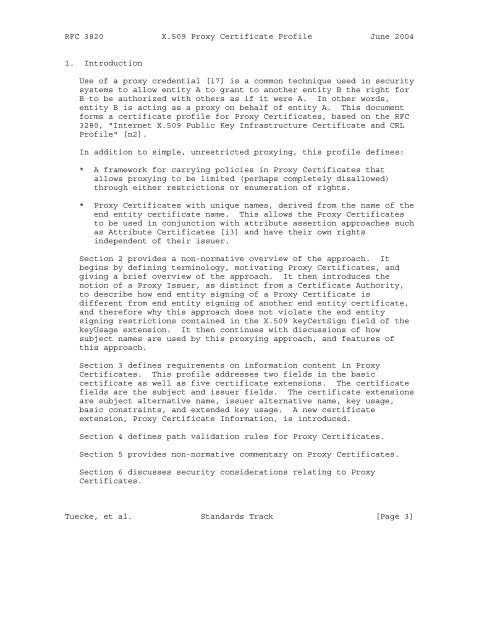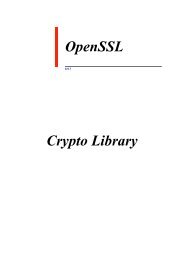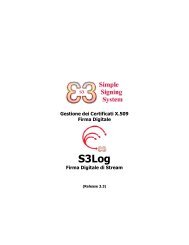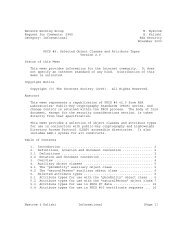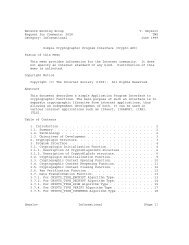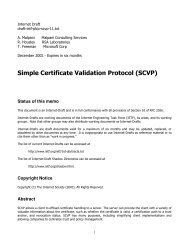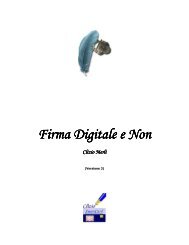Internet X.509 Public Key Infrastructure (PKI) Proxy ... - Clizio.com
Internet X.509 Public Key Infrastructure (PKI) Proxy ... - Clizio.com
Internet X.509 Public Key Infrastructure (PKI) Proxy ... - Clizio.com
You also want an ePaper? Increase the reach of your titles
YUMPU automatically turns print PDFs into web optimized ePapers that Google loves.
RFC 3820 <strong>X.509</strong> <strong>Proxy</strong> Certificate Profile June 20041. IntroductionUse of a proxy credential [i7] is a <strong>com</strong>mon technique used in securitysystems to allow entity A to grant to another entity B the right forB to be authorized with others as if it were A. In other words,entity B is acting as a proxy on behalf of entity A. This documentforms a certificate profile for <strong>Proxy</strong> Certificates, based on the RFC3280, "<strong>Internet</strong> <strong>X.509</strong> <strong>Public</strong> <strong>Key</strong> <strong>Infrastructure</strong> Certificate and CRLProfile" [n2].In addition to simple, unrestricted proxying, this profile defines:* A framework for carrying policies in <strong>Proxy</strong> Certificates thatallows proxying to be limited (perhaps <strong>com</strong>pletely disallowed)through either restrictions or enumeration of rights.* <strong>Proxy</strong> Certificates with unique names, derived from the name of theend entity certificate name. This allows the <strong>Proxy</strong> Certificatesto be used in conjunction with attribute assertion approaches suchas Attribute Certificates [i3] and have their own rightsindependent of their issuer.Section 2 provides a non-normative overview of the approach. Itbegins by defining terminology, motivating <strong>Proxy</strong> Certificates, andgiving a brief overview of the approach. It then introduces thenotion of a <strong>Proxy</strong> Issuer, as distinct from a Certificate Authority,to describe how end entity signing of a <strong>Proxy</strong> Certificate isdifferent from end entity signing of another end entity certificate,and therefore why this approach does not violate the end entitysigning restrictions contained in the <strong>X.509</strong> keyCertSign field of thekeyUsage extension. It then continues with discussions of howsubject names are used by this proxying approach, and features ofthis approach.Section 3 defines requirements on information content in <strong>Proxy</strong>Certificates. This profile addresses two fields in the basiccertificate as well as five certificate extensions. The certificatefields are the subject and issuer fields. The certificate extensionsare subject alternative name, issuer alternative name, key usage,basic constraints, and extended key usage. A new certificateextension, <strong>Proxy</strong> Certificate Information, is introduced.Section 4 defines path validation rules for <strong>Proxy</strong> Certificates.Section 5 provides non-normative <strong>com</strong>mentary on <strong>Proxy</strong> Certificates.Section 6 discusses security considerations relating to <strong>Proxy</strong>Certificates.Tuecke, et al. Standards Track [Page 3]


